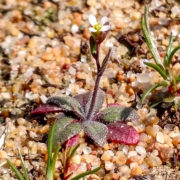Life on the edge prepares plants for climate change
Life on the edge prepares plants for climate change
In the first study to predict whether different populations of the same plant species can adapt to climate change, we found that central European populations of A. thaliana are most at risk.
We investigated A. thaliana because it grows across a very wide geographic range. Surprisingly, Scandinavian plants can cope with extreme drought as well as those from Mediterranean countries, according to our study research just published in Nature Ecology and Evolution. This could be because water in the Scandinavian soil is frozen for many months, making it inaccessible to plants and effectively creating drought conditions.
We planted seeds collected from over two hundred locations as diverse as North Africa, Spain, central Europe and northern Sweden. After they had germinated under optimal conditions, we challenged them with severe drought, and recorded their ability to survive this stress. Using large-scale genome sequencing information, specific genetic variants could be linked to the plants’ ability to survive longer. Combined with climate predictions from the Intergovernmental Panel on Climate Change, we could generate maps showing the location of genetic variants key to the species’ future survival.
Over the next 50 to 100 years, extreme drought events are predicted to become more and more widespread. This is one of the most challenging consequences of global warming for plants and animals. A steady increase in temperatures is already underway, but this and other studies show that reduced rainfall, which will affect plants and humans alike in a less linear way, is likely to have an even greater effect on survival. By 2070, Central Europe is likely to have much less rainfall than today. Our new research shows that plants in this region do not have the gene variants needed to adapt.
Previous predictions for the distribution of plants or animals in response to climate change have largely ignored the fact that there is often a tremendous amount of genetic variation in a species. For the first time, knowledge about the geographic distribution of genetic variation has been used to map a species’ ability to adapt by natural selection.




